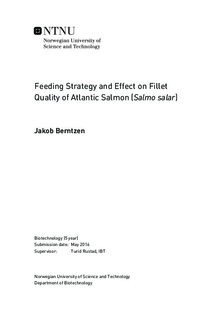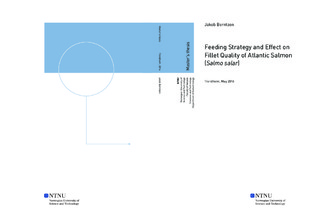| dc.description.abstract | This thesis seeks to explore how changes in feeding strategy can affect the fillet quality of farmed Atlantic salmon (Salmo salar). By changing the number of daily feedings or the degree of marine raw materials it will be reasonable to expect an effect from some of the main quality parameters in fish fillet. The thesis consists of two separate experiments. In the feed frequency experiment protein solubility, colouration, dry matter, lipid content and lysosomal protease activity was compared for fish fed one and three times daily. The results indicate that the group fed three times per day had wider spread in colouration, lower lipid content, higher content of sarcoplasmic proteins and lower cathepsin B+L activity compared to fish fed one time daily. No significant difference was detected in mean colouration, fillet hardness, breaking strength or water contents from changes in feeding rate.
In the diet experiment, five groups of Atlantic salmon were reared in full-scale net pens and fed with marine based feed (MBF) at different durations under the growth phase (Group A: 41 weeks, B: 40 weeks, C: 27 weeks, D: 25 weeks and E: 0 weeks). A conventional industrial feed (CF) was otherwise used. Pigmentation, lipid content, fatty acid profile, amino acid profile and water content was compared between the groups. Changes of lipid content and colouration was compared in fresh fish and after freeze storage using visual analysis, NIR and UV spectrometry. Amino acids, fatty acids and water content was examined after freeze storage. Growth, weight spread, downgrading content, feed factors and visceral deposition was compared from slaughter data for the different feeding groups. Results indicates that increased dietary marine feed can lead to higher growth rates, lower feed factor, stronger red pigmentation, higher lipid contents, changes in amino acid profile and visceral deposition. No significant differences was detected in protein content, water content or superior quality grading. UltraPerformance Convergence Chromatography^{TM} (UPC^{2}) may be a possible method for screening of fatty acid profile of unestrified fatty acids of fish fillets, however further method development are needed to clarify its potential.
These experiments shows that chosen feeding strategy can have an impact on several growth and quality parameters in Atlantic salmon.Further research is recommended in order to describe the mechanisms underlying these observations. The development into more sustainable feed raw materials still results in high quality products. | en |

